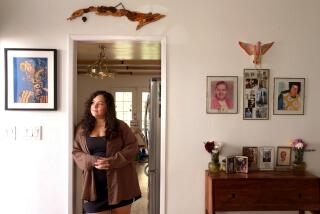Drawn Into the Future
- Share via
One of the students is an eighth-grader. Several are middle-aged people with jobs. Four are high school teachers, and the rest a combination of high school students and recent graduates.
For eight weeks, they are working with each other to make animated films.
This diverse group was drawn together in one of five summer boot camps that are part of a broad campaign to equip Los Angeles students with the skills required by the region’s burgeoning high-tech entertainment industry.
The 49 students meet eight hours a day at the Los Angeles Unified School District’s Abraham Friedman Occupational Center, a cavernous building in downtown’s industrial area.
Divided into several production units, they are creating 90-second animated videos that tell fanciful stories, such as one about a clash between a pencil and an eraser and another about how a discarded bicycle becomes a museum sculpture.
The boot camp is one of five held this summer, primarily to train teachers for the high-tech campaign by having them work side by side with students. These teachers will then take their new knowledge to the New Media Academies that are popping up in Los Angeles high schools.
Six of the academies have been set up and two more are being added this year, all with a $2.6-million grant from the U.S. Department of Education. Those already in operation are at Hollywood, Palisades Charter, Crenshaw, Venice, Vergugo Hills and Manual Arts high schools. The two new ones will be at Cleveland and Eagle Rock high schools.
The academies, launched two years ago, offer traditional courses with an emphasis on computer technology. Instructors teaching about government, for example, use computer mapping software to teach concepts such as political apportionment and city planning. The academies also offer special courses that develop high-tech job skills.
At full strength, the sites will each have 200 to 250 students enrolled in four-year programs.
The academies have attracted a high percentage of students who were on the verge of dropping out, said Deborah Brooks, president of Workforce LA, a nonprofit corporation that works with L.A. Unified on its technology programs.
“These technologies engage them so much that we find they are more successful in their academic studies,” she said.
Some leave high school ready for jobs in the entertainment business, and others go on to college, she added.
Workforce LA was formed in 1988 as a cooperative venture of the school district, the city of Los Angeles and businesses to advance programs that will train the workers needed by the region’s high-tech industries, especially entertainment.
Each of this summer’s boot camps emphasized a specialty, from animation to computer mapping technology. Some were exclusively for teachers, but others admitted students and mid-career adults. Teachers are paid to take the course, while students can earn school credit.
The animation workshop drew a diverse group.
Rene Almenar, 20, hopes to get a job in animation. He was teamed with Jackie Green, an eighth-grader at St. Bernard’s Catholic School who takes every art class she can, and Octavio Marquez, a professional illustrator who wants to improve the quality of his line drawing.
Instructor Ray Seay guided the students in blocking out their plots on storyboards and brought in guest lecturers to give them an inside look at the industry.
One day he invited a klatch of professional actors who performed the scenes while being videotaped. The students later studied the videos, one frame at a time, to capture real human expression in their characters’ movements.
For the teachers, the lessons of animation are more subtle.
Some plan to have their students use animation to invigorate their lessons in math or economics.
Others were getting ideas for using new forms of technology, from the cameras that film the students’ work to the computer that mixes the sound.
Jim Debiase, a teacher at Venice High, said the most useful lessons for him were in ways to involve students in complex tasks.
“It’s something totally different . . . very much like learning about teaching all over again,” he said. “One thing I really hope to do is build more of a project orientation in my teaching.”







